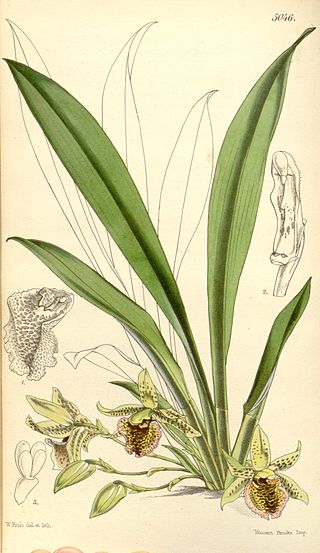
Phragmipedium is a genus of the Orchid family (Orchidaceae) and the only genus comprised in the tribe Phragmipedieae and subtribe Phragmipediinae. The name of the genus is derived from the Greek phragma, which means "division", and pedium, which means "slipper". It is abbreviated 'Phrag' in trade journals.

Stanhopea is a genus of the orchid family (Orchidaceae) from Central and South America. The abbreviation used in horticultural trade is Stan. The genus is named for the 4th Earl of Stanhope (1781-1855), president of the Medico-Botanical Society of London (1829-1837). It comprises 55 species and 5 natural hybrids. These epiphytic, but occasionally terrestrial orchids can be found in damp forests from Mexico to Trinidad to NW Argentina. Their ovate pseudobulbs carry from the top one long, plicate, elliptic leaf.

Brassia is a genus of orchids classified in the subtribe Oncidiinae. It is native to Mexico, Central America, the West Indies, and northern South America, with one species extending into Florida.

Sobralia is a genus of orchids native to Mexico, Central and South America. The plants are more commonly terrestrial, but are also found growing epiphytically, in wet forests from sea level to about 8,800 ft. The genus was named for Dr. Francisco Sobral, a Spanish botanist. The genus is abbreviated Sob in trade journals.

Microchilus is a neotropical genus of about 261 species belonging to the orchid family (Orchidaceae). The native range of this genus is tropical & subtropical America.

Ponthieva is a genus in the orchid family (Orchidaceae), commonly known as the shadow witch. They are named after Henry de Ponthieu, an English merchant of Huguenot ancestry who sent West Indian plant collections to Sir Joseph Banks in 1778.

Stenia is a genus in the orchid family (Orchidaceae). It was established by John Lindley in 1837. These epiphytic plants occur in warm, humid habitats of Trinidad and the Amazonian slope of the northern Andean region in South America.

Huntleya is a small orchid genus native to South America, Central America and Trinidad.

Cycnoches, abbreviated as Cyc. in the horticultural trade, is a genus of 34 currently accepted species of orchids native to South America, Central America and southern Mexico. Also called "swan orchids", they are epiphytes found in lowland and pre-montane forests.

Rodriguezia, abbreviated Rdza. in the horticultural trade, is a genus of orchids. It consists of 49 known species, native to tropical America from southern Mexico and the Windward Islands south to Argentina, with many of the species endemic to Brazil.

Teuscheria is a genus of orchids native to southern Mexico, Central America and northern South America. The genus is named for Henry Teuscher, an award-winning landscape artist and horticulturalist.

Polycycnis, abbreviated in horticultural trade as Pcn, is a genus of orchid, comprising 17 species found in Central America, and northern South America.

Sievekingia is a genus of orchid, comprising 20 species found in Central and South America, from Nicaragua east to the Guianas and south to Bolivia.

Scaphyglottis is a genus of orchids native to Mexico, Central America, northern South America and parts of the Caribbean. The current concept of this genus is the result of combining several genera which have been described at various times. The concept is characterized by the growth habit: not only are new pseudobulbs added at the base of the old ones, but new pseudobulbs also grow at the apices of the old ones. Many species are quite similar and difficult to distinguish, but some are clearly distinct. A few have showy colors. The genus comprises nearly 70 species.

Kefersteinia is a genus of flowering plants from the orchid family, Orchidaceae. It has about 40-50 species, widespread across much of Latin America. The genus was named for Keferstein of Kröllwitz, an orchidologist.

Koellensteinia is a genus of flowering plants from the orchid family, Orchidaceae. It is named by Heinrich Gustav Reichenbach for the Captain Carl Kellner von Koellenstein, an Austrian military officer and a botanical correspondent of Reichenbach.

Pescatoria is a genus of flowering plants from the orchid family, Orchidaceae. It is native to Costa Rica, Panama, and northern South America.

Psilochilus is a genus of flowering plants from the orchid family, Orchidaceae. It is native to South America, Central America, Mexico and the West Indies.
- Psilochilus carinatusGaray - Colombia
- Psilochilus dusenianusKraenzl. ex Garay & Dunst. - Venezuela, Brazil
- Psilochilus macrophyllus(Lindl.) Ames - widespread from central Mexico and the West indies south to Peru
- Psilochilus maderoi(Schltr.) Schltr. - Colombia
- Psilochilus modestusBarb.Rodr. - Venezuela, Brazil
- Psilochilus mollisGaray - Ecuador
- Psilochilus physurifolius(Rchb.f.) Løjtnant - Venezuela, Guyana
- Psilochilus vallecaucanusKolan. & Szlach. - Colombia

Warczewiczella is a genus of orchids native to South America, Central America, and Cuba.
- Warczewiczella amazonicaRchb.f. & Warsz. - Colombia, Ecuador, Peru, Brazil
- Warczewiczella candida(Lindl.) Rchb.f. - Brazil
- Warczewiczella discolor(Lindl.) Rchb.f. - Colombia, Ecuador, Peru, Venezuela, Cuba, Costa Rica, Honduras, Panama
- Warczewiczella guianensis(Lafontaine, G.Gerlach & Senghas) Dressler - Guyana, Suriname, French Guiana
- Warczewiczella ionoleuca(Rchb.f.) Schltr. - Colombia, Ecuador
- Warczewiczella lipscombiae(Rolfe) Fowlie - Panama
- Warczewiczella lobata(Garay) Dressler - Colombia
- Warczewiczella marginataRchb.f. - Panama, Colombia, Venezuela
- Warczewiczella palatina(Senghas) Dressler - Peru, Bolivia
- Warczewiczella timbiensisP.Ortiz - Colombia
- Warczewiczella wailesiana(Lindl.) E.Morren - Brazil

Chondroscaphe is a genus of orchids native to southeastern Central America and northwestern South America.
- Chondroscaphe amabilis(Schltr.) Senghas & G.Gerlach in F.R.R.Schlechter - Ecuador, Colombia
- Chondroscaphe atrilinguisDressler - Costa Rica, Panama
- Chondroscaphe bicolor(Rolfe) Dressler - Costa Rica, Panama
- Chondroscaphe chestertonii(Rchb.f.) Senghas & G.Gerlach in F.R.R.Schlechter - Ecuador, Colombia
- Chondroscaphe dabeibaensisP.A.Harding - Colombia
- Chondroscaphe eburnea(Dressler) Dressler - Panama
- Chondroscaphe embreei(Dodson & Neudecker) Rungius - Ecuador, Colombia
- Chondroscaphe escobariana(Dodson & Neudecker) Rungius - Colombia
- Chondroscaphe flaveola(Linden & Rchb.f.) Senghas & G.Gerlach in F.R.R.Schlechter - Colombia, Venezuela, Peru
- Chondroscaphe gentryi(Dodson & Neudecker) Rungius - Ecuador
- Chondroscaphe merana(Dodson & Neudecker) Dressler - Ecuador
- Chondroscaphe plicata(D.E.Benn. & Christenson) Dressler - Peru
- Chondroscaphe venezuelanaPupulin & Dressler - Venezuela
- Chondroscaphe yamilethaePupulin - Costa Rica




















